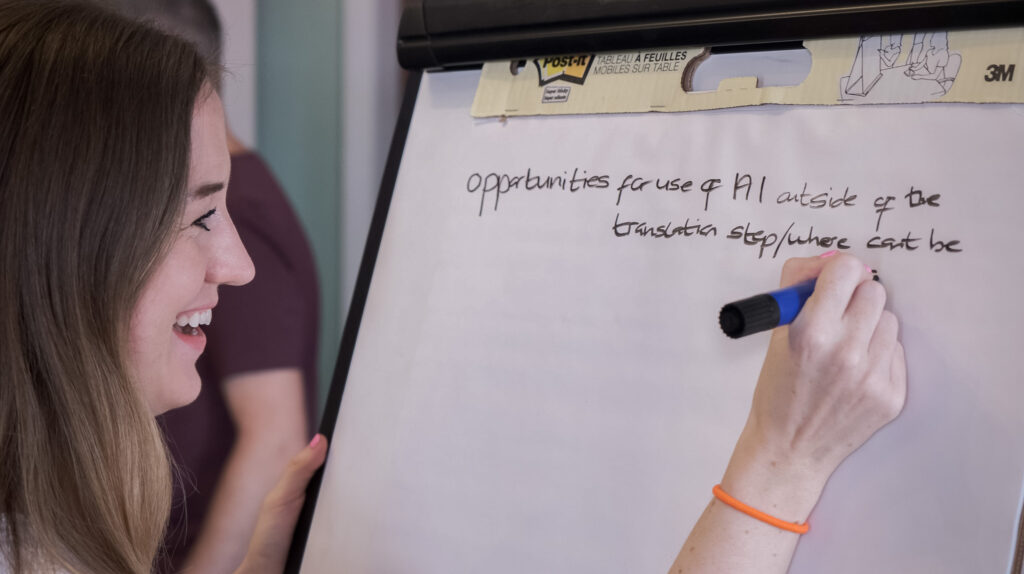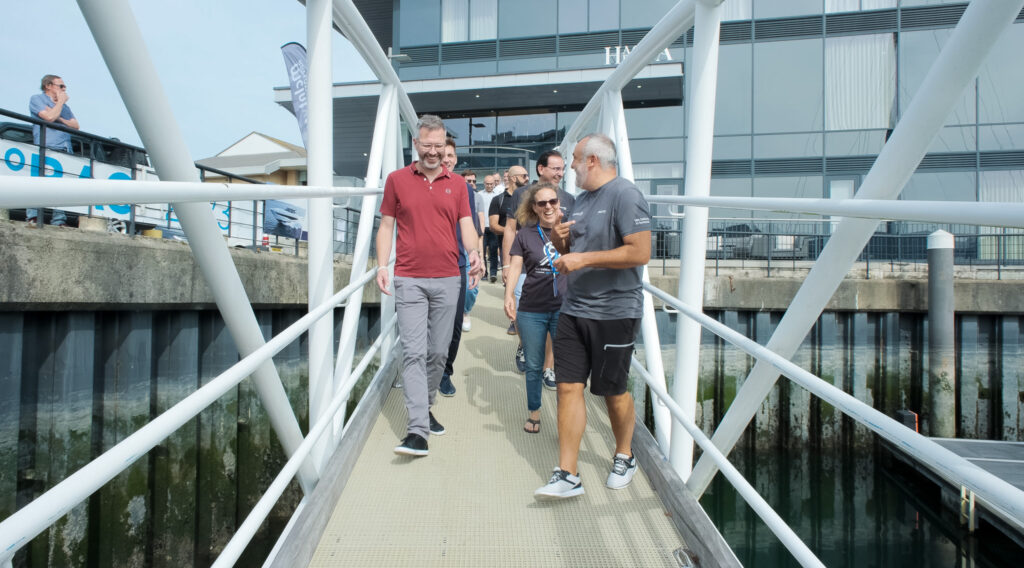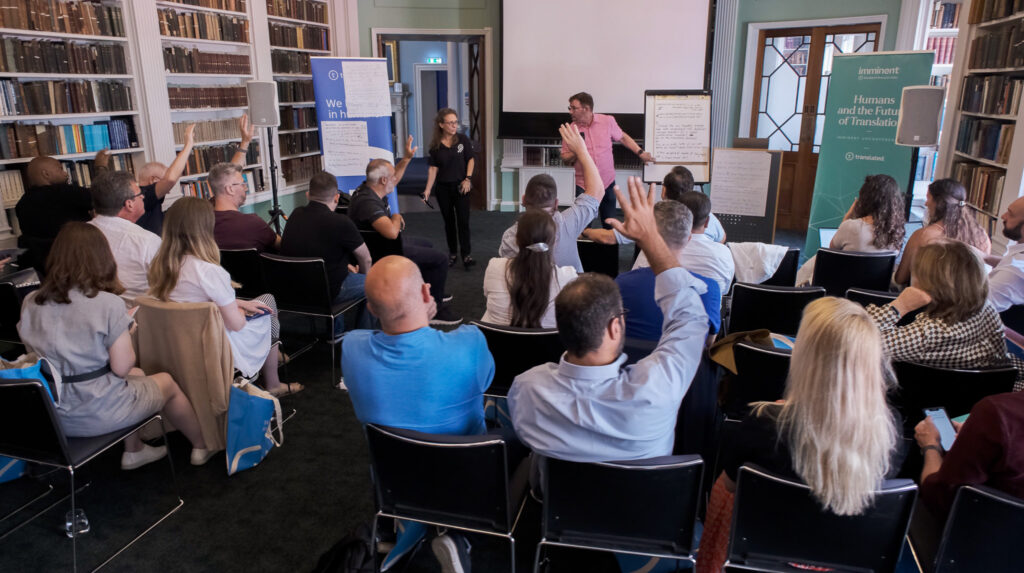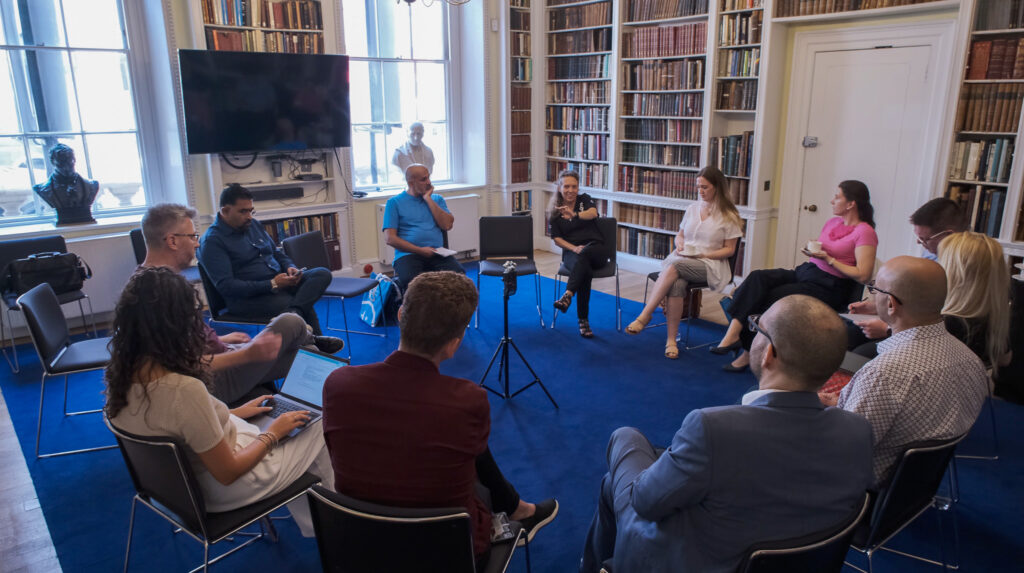Trends
Main topics and issues discussed
at the Imminent Unconference in London/Southampton

London, September 7th, 2023. 30 leaders in the field of translation, localization, and artificial intelligence came together for the first ever Imminent Unconference on the theme of “Humans and the Future of Translation”.
An unconference is a loosely structured conference with no set program of events that aims to emphasize the informal exchange of information and ideas between participants. The following are four major subjects that were discussed.
1. From and into which languages should we translate?
“A great wave is coming, with demand for more languages and viewpoints: we need systems that are more context-aware”
What Drives Change?
The digital landscape is undergoing rapid transformation, with regions like Africa and South Asia at the forefront of this change. These areas are witnessing a growth that could potentially exceed our expectations. This evolution is not a distant possibility but a current reality. One of the most significant aspects of this transformation is the increasing importance of languages and their complexities. First and foremost, beyond mere translation, languages, including various dialects and subsets, are becoming potent catalysts for social change, especially in those regions. As we move forward, AI systems and communication platforms will need to cater to not just different languages but also diverse dialects. This complexity of languages and cultures is poised to escalate, necessitating a fresh perspective on how to understand and manage this diversity. However, a concerning disparity exists between dominant languages, for which there is abundant data, and the myriad of others. This growing gap poses a challenge for the entire industry.
What Questions Arise?
With the evolving digital landscape, several pertinent questions emerge. How can we move beyond a monolithic perspective on languages and adopt a more fluid approach? How do we address the widening gap between those who speak commercially dominant languages and those who do not? The challenge is not just about multilingualism in terms of sheer numbers, but also understanding the context. As we witness the rise of regions like India and Africa in the digital realm, how do we navigate the unique linguistic and jurisdictional complexities that they present? Is the language barrier restricting market opportunities? With a declining global interest in learning foreign languages, largely due to limited internet penetration in certain countries, how does this shift impact the industry? As emerging markets like Nigeria come to the forefront, how do we cater to their linguistic diversity and specific needs? Do these regions prefer content in English, or would they rather have it in their native languages? Could political entities play a role in preserving endangered languages and ensuring linguistic equality?
What Different Answers Emerge?
Understanding the language preferences of your audience is fundamental. Offering content in native languages can be a game-changer, as evidenced by the success of products like Facebook in Swahili.
“Look at languages as a feature and advertise it!”
Tailored localization strategies are essential for regions with distinct linguistic and jurisdictional challenges. Interestingly, countries that had previously lagged due to low internet penetration are now emerging as significant players. Therefore, the industry must recognize that relying solely on English as a source language is no longer adequate. Market success is increasingly linked to countries sharing a language and having a high GDP. However, for emerging markets with linguistic diversity and lower GDP, specialized globalization expertise is needed. There is evidence that many users with English interfaces still search in their local languages and, additionally, crowdsourcing for data collection and AI training can bolster future localization efforts. Organizations like the United Nations are examining their role in AI governance and supporting the “Global South”, emphasizing the importance of these issues. Digital inclusion and the empowerment of language communities is vital for inclusive globalization, where languages should be celebrated and promoted, as they are not just tools but bridges that connect and empower global communities. The localization industry’s challenge is to prepare for the next four billion people entering the digital realm. The potential business value of localization is immense and is waiting to be tapped and there is a pressing need for setting a scientific research agenda. As we navigate this process, we must cherish languages as connectors that shape our global future.

2. Do cultural nuances still matter in translation today?
“Companies that forget the values of their audience are bound to trivialize their message. Cultural nuances can be cut out, but they will come back”
What Drives Change?
The evolution of the localization industry has been marked by a significant shift toward internationalization and standardization. From the outset, the primary objective was to find a common ground, which meant eliminating idioms, nuances, peculiarities, shades, and identities. This trend was driven by industry demands at the time. Today, much of the content we consume – whether on social media, television, websites, or the physical market – is predominantly in English. This shift toward a single language reflects a broader trend of homogenization, where the unique cultural nuances that once characterized different languages are gradually fading. As a result, the industry’s approach has been to create a singular, easily translatable language, rather than embracing the richness and diversity of each individual one.
What Questions Arise?
Given the current trajectory of the localization industry, several pressing questions emerge. Even if nuances have an essential cultural value for each community, do they still hold significance in translation and localization today? In a world that had seemed, for a while at least, to be gravitating toward fewer linguistic identities, is there still room for the myriad cultural shades that exist among the thousands of global cultures? What exactly do we mean by nuances? These are the subtle differences that set each community apart, rooted in their history, cultural specificities, and social contexts. As these differences become increasingly blurred, it begs the question: If we continue to strip our languages of these unique cultural markers, will we eventually converge into speaking a single, homogenized language?
What Different Answers Emerge?
Nuances, which constantly evolve with society and with the idiom they belong to, play a pivotal role in shaping communities. As a matter of fact, while languages facilitate communication, their cultural aspects are what truly bind people together.
“If you are talking about translation you are putting yourself into the mind and context of somebody else”
In the past, when translation was solely a human endeavor, these nuances were often viewed as obstacles and therefore erased. However, what we need to understand in this AI-driven era is that, even though a product is well translated and communicated, the essence lies in nuances, because they are the basis (and the bias) of each community.
While machines can generate understandable words, they lack the human depth of understanding, ethics, empathy, a human body (and therefore an end), becoming tangible examples of something more similar to an artificial unconsciousness. It seems that we are actually entering an era of engineering without science, where humans are not aware of the process, but look just at the output. For these reasons, what we do not have to forget is that humans still play a crucial role, as they are the ones who infuse culture into technology, enhancing that output. With the advent of AI, we have the potential to revolutionize content creation, fostering cultural identities. To preserve cultures, there is a need to promote local brands, shunning standardized markets, and to identify the types of nuances (in text, voice, etc.) in order to explore how technology can be leveraged, always remembering that humans play a vital role in the final stages. In essence, while technology serves as the hammer, humans act as the chisel. Comprehension and nuances are intertwined; understanding and culture are inseparable.Translators bear the significant responsibility of bridging localization with the target context, transforming mere translation into transcreation, where a product not only speaks different languages but also resonates with diverse cultures.

3. Where is the translation industry headed?
“Translation is about trust: the goal is to make people feel understood”
What Drives Change?
The translation industry is undergoing a significant transformation, primarily driven by the integration of artificial intelligence (AI). When approaching the topic of translation in the era of AI, we already observe companies adjusting the scope of their work. AI offers the chance to reevaluate and realign localization teams, making them more attuned to the organization’s needs and market dynamics. The localization team’s positioning within the company is a critical consideration, since, depending on where it is located, its role and impact can vary significantly, also in relation to its access to the company’s budget. In addition, one of the most notable shifts is the evolving role of today’s translators. With the rise of AI, they are transitioning from being primary content creators to reviewers of machine-generated translations. They now act as “quality gatekeepers”, both ensuring the accuracy and nuances of AI-generated content and to train machines for quality translations. As AI systems become more ingrained in translation workflows, the roles and expectations of translators are changing significantly.
What Questions Arise?
With the changes brought about by AI, several questions emerge. Where are we headed to, both as humans and as translators? What will the future’s localization team look like? Will they become obsolete, or will they adapt to new challenges and broaden their influence? The future of localization teams is not just about their size but also about their positioning within the organization. Will they be pivotal in the supply chain, the user experience chain, or the product development chain? Depending on their placement – be it under growth, sales, or another department – their role and impact can differ greatly. Another pressing question is how do we prepare linguists for future roles? How do we ensure their digital onboarding? As technology reshapes the industry, many linguists face uncertainty about their job prospects. How can they be trained to ensure AI learns correctly from the outset, and how can they transition into new roles using advanced tools?
What Different Answers Emerge?
Various answers and perspectives emerge in response to the questions posed. To advocate the value of localization, it is vital to champion its importance and ensure it acts as a growth catalyst within the organization.
“Where is the position of localization? As a growth accelerator.”
Upskilling is one solution. Translators can move into new roles, such as voice-over work, using cutting-edge tools and technologies. This shift highlights the need to reposition localization teams within companies. Localization industry leaders must anticipate AI’s growth trajectory, which involves identifying emerging needs in various departments and taking appropriate action. Until the moment where opportunity is created, it seems like English is the optimal solution. However, English is an asset and not an option. In this sense, the role of localization may evolve into more of a support function than a purely strategic one. The intricacy of languages will result in a higher volume of content needing translation and more comprehensive training for AI models, which represents both a challenge and an opportunity. In an era where translating user-generated content is gaining prominence, it is possible to maintain team size while repurposing skills for different tasks. The emphasis should move from merely managing content volume to addressing the diversity of languages involved. In this context, data becomes crucial for successful localization in the AI era. In fact, there have also been predictions that the translation cost for some languages may approach zero, depending on the availability of adequate data. In conclusion, the key to thriving in this changing landscape lies in anticipating the growth of AI, investing in training and upskilling, and understanding the pivotal role of data in the future of translation.

4. How to grow up in the era of AI?
“Managers who believe in it, they do it. Managers who don’t believe in it, they ask: ‘Show me the numbers’”
What Drives Change?
The translation industry is undergoing a monumental shift, primarily driven by the advent of AI. New generations of linguists are at the forefront of this transformation, and it is radically altering how they perceive, learn, and operate. In general, for the younger generation, aspirations and dreams often hold more weight than material possessions. This shift in values has led them to lack a pragmatic view of the future. They inherently feel entitled, often taking technology, especially AI, for granted. This results in diminished patience and a reduced appreciation for the processes behind technological advances. Their reality seamlessly blends the physical and digital realms. Their approach to work is also distinct: they are willing to work hard, but only on tasks they are passionate about. They seek purpose in their work and prioritize a balanced work-life dynamic, keen on avoiding burnout – a state they already feel they’re in.
What Questions Arise?
Despite their ambitions and unique perspective, it appears that the world is not adequately preparing the younger generation for the challenges ahead. In the AI-driven era, there is a pressing need for young individuals to grasp how to harness technology to their advantage and derive satisfaction from their professional lives. However, the current educational system seems not ready to impart these essential life skills. Specifically, language and translation students often find themselves unprepared for the real-world demands of the translation industry. The skills and knowledge they acquire at universities often do not align with the practical requirements of their jobs. This misalignment raises critical questions: How can we bridge this gap? Who should guide them in effectively leveraging technology for their future careers? Is the education system, which increasingly feels like a privilege rather than a right, failing them? And are we, as a society, asking the right questions and addressing the genuine concerns of young translators about their future?
What Different Answers Emerge?
The challenges faced by the younger generation are multifaceted, and addressing them requires a comprehensive approach. Undoubtedly, a significant part of the solution lies in reforming the education system to make it more inclusive and attuned to the evolving needs of society. The focus should shift from traditional job roles to exploring new (or even less) avenues and professions that are emerging in a new economic system, which is based on the equation of energy with wealth. While AI offers numerous advantages, it also poses the risk of stifling human potential.
“The challenge is: do we need to use AI to augment time to relax, or to reach our real purposes?”
There is a growing sentiment that over-reliance on technology is making humans complacent and less intelligent. This brings forth a pivotal question: How can individuals maintain their unique human essence in an overwhelmingly technological environment? The upcoming generation faces the daunting task of navigating an ultra-competitive landscape where skills become the primary currency. It is crucial to engage young translators and language experts directly, seeking their insight into their aspirations and concerns. Professionals in the translation and localization industry bear the responsibility for mentoring these budding translators. They must guide them in harnessing AI’s potential and thriving in this ambitious yet intimidating era.



